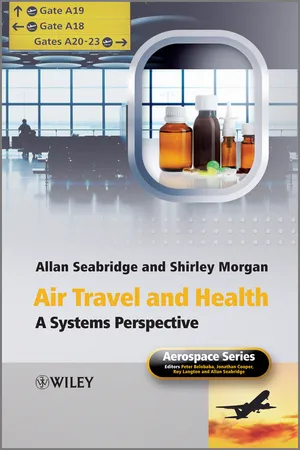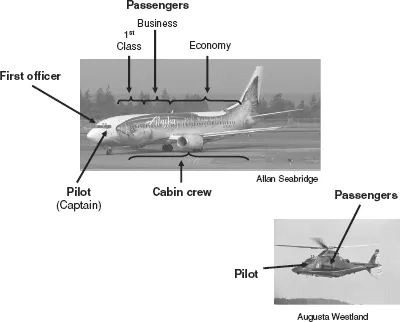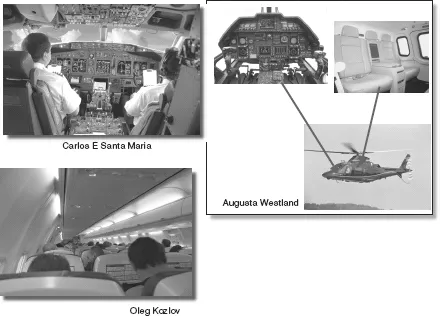
eBook - ePub
Air Travel and Health
A Systems Perspective
Allan Seabridge, Shirley Morgan, Peter Belobaba, Jonathan Cooper, Roy Langton
This is a test
Share book
- English
- ePUB (mobile friendly)
- Available on iOS & Android
eBook - ePub
Air Travel and Health
A Systems Perspective
Allan Seabridge, Shirley Morgan, Peter Belobaba, Jonathan Cooper, Roy Langton
Book details
Book preview
Table of contents
Citations
About This Book
Providing a detailed examination of the issues that affect the long term health of aircrew, cabin crew and passengers, Air Travel and Health offers guidance to engineers designing aircraft in the difficult field of legislation and product liability. Examining the facts, anecdotes and myths associated with health and travel, Seabridge and Morgan draw balanced conclusions on which the aircraft operations and design communities can act to provide cost-effective solutions. The authors present a useful reference for aircrew, regulatory authorities, engineers and managers within the aerospace industry, and medical and human factor specialists, as well as an informative resource for undergraduate and graduate students.
Frequently asked questions
How do I cancel my subscription?
Can/how do I download books?
At the moment all of our mobile-responsive ePub books are available to download via the app. Most of our PDFs are also available to download and we're working on making the final remaining ones downloadable now. Learn more here.
What is the difference between the pricing plans?
Both plans give you full access to the library and all of Perlego’s features. The only differences are the price and subscription period: With the annual plan you’ll save around 30% compared to 12 months on the monthly plan.
What is Perlego?
We are an online textbook subscription service, where you can get access to an entire online library for less than the price of a single book per month. With over 1 million books across 1000+ topics, we’ve got you covered! Learn more here.
Do you support text-to-speech?
Look out for the read-aloud symbol on your next book to see if you can listen to it. The read-aloud tool reads text aloud for you, highlighting the text as it is being read. You can pause it, speed it up and slow it down. Learn more here.
Is Air Travel and Health an online PDF/ePUB?
Yes, you can access Air Travel and Health by Allan Seabridge, Shirley Morgan, Peter Belobaba, Jonathan Cooper, Roy Langton in PDF and/or ePUB format, as well as other popular books in Technology & Engineering & Aeronautic & Astronautic Engineering. We have over one million books available in our catalogue for you to explore.
Information
1
Introduction
The days are long gone when people flew for the very adventure of flying, when in-flight entertainment was looking out of the window and in-flight catering was the offer of a barley sugar sweet.
Lack of sound insulation, large rotary engines and no heating provided a noisy and vibrating environment with only blankets providing some form of comfort. In the armed forces the crew spent many long and miserable hours in terrible conditions, comforted only by glucose tablets.
This age of adventurous flying ushered in travel sweets, still on sale today for the intrepid car user. A.L. Simpkin’s advertising made no mistake about their use in flying:
- ‘Proven to increase energy and relieve the effects of air sickness’;
- ‘… used by RAF personnel for high altitude flying during sorties in WW2’;
- ‘… recommended as a great way to reduce inner ear pressure during flying’.
The practice of giving sweets at take-off persisted even into the 1980s on some airlines. The theory was probably that sucking the sweet or chewing stimulated the nasal passages and ear canal to relieve any build-up of pressure. A technique known as the Vasalva manoeuvre can be used to great effect, which entails closing the mouth and pinching the nose while attempting to exhale. This counteracts the effects of water pressure in the Eustachian tubes to eliminate problems in the middle ear.
1.1 Factors Affecting Health
There are a number of factors originating in the environment of an aircraft that can have an impact on the long-term health of aircrew as a result of prolonged or habitual exposure, and which cannot be alleviated by sucking a boiled sweet. These factors may arise as a result of poor design, but more often than not they are a fact of life, a result of the physics that relates to the operation of a high-speed machine and to the environment in which it operates.
This machine can be considered as the workplace, for aircrew, in which long-term exposure and damage to health may be inevitable unless action is taken to reduce the exposure to specific hazards. In considering the aircraft in this way – as the ‘office’ or workplace – it is no different to the ground-based office or factory in which many humans go to work on a daily basis. Legislation exists to protect them and their employers must respect the law or suffer the consequences.
Passengers are also affected by the environment; they are after all in the same vehicle as the crew. A major difference is that their exposure is transient and irregular.
The conditions that arise from exposure to these factors may lead to problems with health either short term or, in severe cases, chronic ill health. From time to time the press covers some of the health issues of passengers or crew, especially if there is a new outbreak of ill health. The internet also carries articles on the subject and there is serious academic research being carried out to explore some issues. However, on inspection the information and the research appear to be uncoordinated -with issues discussed separately, with no single integrated viewpoint. In this book we will endeavour to bring all aspects of air travel and ill health together in one place and try to draw some conclusions.
1.2 The System of Interest
Figure 1.1 illustrates the system which is the subject of this book, showing the subsystems and their interactions.
1.2.1 The Operating Environment
The operating environment is where the aircraft spends its life – on the ground and in the air. It consists of the natural environment and the aircraft environment. The natural environment is a complex interaction of chemicals and electro-magnetic radiation which forms the Earth’s atmosphere. An excellent description of the atmosphere and the history of the discovery of its constituents can be found in An Ocean of Air (Walker, 2007). Only a small portion of the atmosphere is used by aircraft – up to about 40 000 ft (12000 m) – although some specialised military aircraft operate above this altitude, as shown in Figure 1.2. The recent space-tourist vehicle revealed by Richard Branson is designed to operate up to 360 000 ft.
Figure 1.1 The system of interest.

1.2.2 The Atmosphere
The atmosphere up to these altitudes is hostile to humans and the aircraft must provide some protection. The atmosphere directly affects all humans in the system – aircrew, cabin crew and passengers – but it is modified by the systems of the aircraft to provide a subtly different set of conditions. For example, the cabin conditioning system uses air from the engines to provide a comfortable cabin atmosphere for the inhabitants at the right temperature, pressure and humidity, whilst the engines themselves contribute to the noise and vibration experienced by the structure and the people inside.
Figure 1.2 The atmosphere relevant to air travel.

1.2.3 The Aircraft Inhabitants
The aircraft inhabitants are taken into account in the design of the airframe and the aircraft systems. Human factors are a major element in the design of the flight deck and cabin to provide an environment that is comfortable, safe and easy to use for both crew and passengers. Guidelines developed by aircraft designers or mandated by customers are used to provide a framework for design. The aircraft design is also very much influenced by the requirements of the customer, whose specification or requirements statement will balance safety against performance, including cost and timescales. Major inputs to design are regulatory aspects such as national and international standards, legal aspects of safety, health and safety and product liability, as well as safety implications embodied in the air navigation order (ANO).
Much of the design input is influenced by knowledge emanating from research, technological advances and hands-on experience from previous projects. Medical evidence from crew health checks is used to influence procedures or design, particularly if chronic effects can be proven. At all times the media – both popular and scientific – are prepared to relate anecdotal and research-based information to the public. The internet is a fruitful source of information.
1.2.4 Sources of Environmental Stimuli
A summary of the potential sources of environmental stimuli that may lead to damage to health is illustrated in Figure 1.3.
Inside the dashed oval are the sources that are internal to the aircraft. They are generated by the aircraft or its systems or they exist as a result of the aircraft and the inhabitants. Outside the dashed oval are external sources, over which the designers and operators of aircraft have no control; these sources are natural occurrences or circumstances which must be taken into account in the design or operation of any aircraft.
Figure 1.3 Sources of conditions that may be injurious to health.

1.3 The Aircraft
For design purposes the interior volume of an aircraft is often considered as two separate environments:
1. The airborne uninhabited environment is the space in the fuselage reserved for the installation of equipment such as avionics, for the stowage of cargo and baggage, and for the carriage of weapons or stores. This space may be ventilated, may receive warm air exhausted from the cabin, and may or may not be pressurised.
2. The airborne inhabited environment is the space reserved for occupants who require some form of life support. The space is provided with breathable air, a pressurised environment, heating and/or cooling, a means of preparing food, and suitable toilet and washing facilities.
The occupants are the subject of this book and in order to establish their position in the aircraft this section will describe who they are, where they sit and what their accommodation looks like.
1.3.1 Military Aircraft
Modern military aircraft are designed to perform in harsh conditions and operate to demanding operational performance criteria. For most of their life, though, even in an uncertain world, they rarely achieve the limits of their capability in peace-time operations. Nevertheless, the conditions encountered in flight expose the aircrew to hazards that the office worker would consider to be dangerous to health.
Military aircraft may be considered as two distinctly different types:
1. Fixed-wing or rotary-wing, highly manoeuvrable types which can exert stresses on aircrew for relatively short-duration missions.
2. Fixed-wing or rotary-wing logistic or surveillance types which may have more benign operational conditions, but fly long-duration missions and may expose crews to the same extent as commercial aircraft.
The airborne inhabited environment of some example military types is shown in Figure 1.4, together with the locations of the inhabitants.
The occupants will mostly be armed forces personnel, although there are some roles that may be provided by outsourcing to trusted civilian agencies or government agencies such as the police, coastguard and customs and excise:
Figure 1.4 The airborne inhabited environment of example military types. Reproduced with permission from 1. BAE Systems, 2. AugustaWestland, 3. U.S. Air Force photo/Tech. Sgt. Phyllis Hanson.

- Pilot – the pilot occupies the cockpit of single-seat fast jets, usually alone or in the front seat of two-seat types. Long-duration surveillance or transport types may have a first pilot and second pilot who will exchange pilot and navigator roles at regular intervals.
- Navigator/weapons officer – the navigator occupies the rear seat of fast jet types and doubles up as the systems and weapons officer.
- Flight engineer – some long-range aircraft have a flight engineer, although this role is diminishing with modern flight decks. For example, in the Nimrod MR2 the flight engineer sits behind the two pilots and monitors the performance of the aircraft systems.
- Mission crew – the mission crew usually occupy the cabin of surveillance aircraft, each with a role to perform and usually with a workstation. Figure 1.5 The inhabited sections of military aircraft types. Reproduced with permission from 1. BAE Systems, 2. AugustaWestland, 3. U.S. Air Force photo/Tech. Sgt. Shane A. Cuomo, 4. U.S. Air Force photo/Master Sgt. Lance Cheung.

- Instructor – in training aircraft tandem types the pilot instructor will sit in the rear seat, in a slightly elevated position.
- Pupil/student – the student pilot occupies the front seat of trainer types so that the view from the cockpit is that of the types to which the student is converting.
Examples of the interiors or inhabited sections of these types are illustrated in Figure 1.5.
1.3.2 Commercial Aircraft
Commercial aircraft generally operate in benign conditions with predictable flight envelopes and fly from large airports with facilities for servicing the aircraft and managing the passengers. For the aircrew and cabin crew the aircraft is their place of work and they may spend many hours in the cabin environment. Passengers, even frequent flyers, are not exposed to the environment to the same extent as the crew. A description of a typical commercial airliner and crew actions is given in Midkiff, Hansman and Reynolds (2009).
Figure 1.6 The airborne inhabited environment of example commercial types. Reproduced with permission from 1. Allan Seabridge, 2. AugustaWestland.

The airborne inhabited environment of some example commercial types is shown in Figure 1.6, together with the locations of the inhabitants.
The occupants will mostly be a mixture of crew and passengers:
- Pilot – the pilot occupies the left hand seat of the flight deck and is the captain of the aircraft.
- First officer – the first officer occupies the right hand seat as a fully qualified pilot. The flying task is shared between the first officer and the captain.
- Relief/check pilot – on long-haul flights a relief pilot will be carried, who will rest and sleep in the business or first-class cabin. A jump seat between the two pilots is carried in the event that a check pilot is carried for certain mandatory pilot inspections.
- Flight engineer – if a flight engineer is carried, they will occupy a seat behind the two pilots. Figure 1.7 The inhabited sections of commercial aircraft types. Reproduced with permission from 1. Carlos E Santa Maria. 2. Oleg Kozlov. 3. AugustaWestland.

- Cabin crew – the cabin crew usually occupy the cabin with their own designated seats. Apart from providing meals and service to the passengers, the primary role of the cabin crew is to assist the passengers in the event of an evacuation or in-flight incident.
- Passengers – passengers are housed in cabins that are designed and equipped to a standard determined by the class of travel.
Figure 1.7 illustrates the cabin and flight deck of commercial types.
1.4 Design Considerations
The engineering teams designing these types are aiming to meet customer specifications for performance and logistic support under demanding environmental and operational conditions. Many of these conditions are also inflicted on the aircrew, together with other conditions of operation resulting from inhabiting and operating a complex military machine, most often in peace-time. Singly or in combination, these conditions can have an impact on the physical well-being of aircrew which may be apparent immediately, or may only emerge after a long period of flying. In some cases the effects may appear after flying employment has terminated.
A good systems engineer needs to be mindful of these effects and the conditions most likely to cause them. This will enable the designers of the aircraft to incorporate some alleviating aspects wherever possible, and most certainly to ensure that users of their products are aware of the risks and their duty of care to the aircrew.
‘Mindful’ in this case includes acquiring knowledge and experience and applying it in the engineering design of the aircraft and its systems:
- Knowledge of legislation and its impact on design and operation.
- Awareness of research in the relevant field.
- Awareness of how to merge engineering and aero-medical or physiological aspects.
Mindful may not actually be the correct word. The designer and manufacturer of military aircraft have a responsibility, a duty of care to their own test pilots and to their customers, to ensure that long-term use of the product does not jeopardise aircrew health. Therefore, there is a moral as well as a legal duty of care to users of the product. The operators of commercial aircraft have a similar duty of care to their aircrew, cabin crew and passengers.
Legislati...